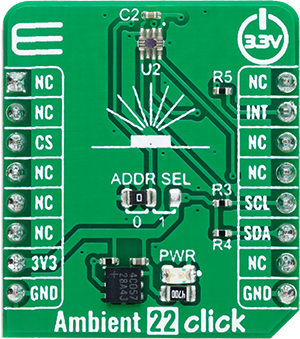
We strongly encourage users to use Package manager for sharing their code on Libstock website, because it boosts your efficiency and leaves the end user with no room for error. [more info]

Rating:
Author: MIKROE
Last Updated: 2024-10-31
Package Version: 2.1.0.7
mikroSDK Library: 2.0.0.0
Category: Optical
Downloaded: 163 times
Not followed.
License: MIT license
Ambient 22 Click is a compact add-on board that measures the intensity of visible light. This board features the OPT3005, a single-chip lux meter from Texas Instruments that transforms light intensity to a digital signal output that can be directly communicated via an I2C interface. The sensor's spectral response tightly matches the human eye's photopic response along with extreme rejection to 850nm and 940nm infrared light over a wide angle of incidence. Measurements can be made from 20mlux up to 166klux without manually selecting full-scale ranges using the built-in, full-scale setting feature.
Do you want to subscribe in order to receive notifications regarding "Ambient 22 Click" changes.
Do you want to unsubscribe in order to stop receiving notifications regarding "Ambient 22 Click" changes.
Do you want to report abuse regarding "Ambient 22 Click".
| DOWNLOAD LINK | RELATED COMPILER | CONTAINS |
|---|---|---|
| 5177_ambient_22_click.zip [401.45KB] | mikroC AI for ARM GCC for ARM Clang for ARM mikroC AI for PIC mikroC AI for PIC32 XC32 GCC for RISC-V Clang for RISC-V mikroC AI for AVR mikroC AI for dsPIC XC16 |
|
Ambient 22 Click is a compact add-on board that measures the intensity of visible light. This board features the OPT3005, a single-chip lux meter from Texas Instruments that transforms light intensity to a digital signal output that can be directly communicated via an I2C interface. The sensor's spectral response tightly matches the human eye's photopic response along with extreme rejection to 850nm and 940nm infrared light over a wide angle of incidence. Measurements can be made from 20mlux up to 166klux without manually selecting full-scale ranges using the built-in, full-scale setting feature.

We provide a library for the Ambient 22 Click as well as a demo application (example), developed using MikroElektronika compilers. The demo can run on all the main MikroElektronika development boards.
Package can be downloaded/installed directly from NECTO Studio Package Manager(recommended way), downloaded from our LibStock™ or found on Mikroe github account.
This library contains API for Ambient 22 Click driver.
ambient22_cfg_setup Config Object Initialization function.
void ambient22_cfg_setup ( ambient22_cfg_t *cfg );ambient22_init Initialization function.
err_t ambient22_init ( ambient22_t *ctx, ambient22_cfg_t *cfg );ambient22_default_cfg Click Default Configuration function.
err_t ambient22_default_cfg ( ambient22_t *ctx );ambient22_get_int_pin This function returns the INT pin logic state.
uint8_t ambient22_get_int_pin ( ambient22_t *ctx );ambient22_read_lux This function checks for a conversion ready flag bit and then reads the ambient light level in lux.
err_t ambient22_read_lux ( ambient22_t *ctx, float *lux );ambient22_write_register This function writes a desired data to the selected register by using I2C serial interface.
err_t ambient22_write_register ( ambient22_t *ctx, uint8_t reg, uint16_t data_in );This example demonstrates the use of Ambient 22 Click board by measuring the ambient light level in lux.
The demo application is composed of two sections :
Initializes the driver and performs the Click default configuration.
void application_init ( void )
{
log_cfg_t log_cfg; /**< Logger config object. */
ambient22_cfg_t ambient22_cfg; /**< Click config object. */
/**
* Logger initialization.
* Default baud rate: 115200
* Default log level: LOG_LEVEL_DEBUG
* @note If USB_UART_RX and USB_UART_TX
* are defined as HAL_PIN_NC, you will
* need to define them manually for log to work.
* See @b LOG_MAP_USB_UART macro definition for detailed explanation.
*/
LOG_MAP_USB_UART( log_cfg );
log_init( &logger, &log_cfg );
log_info( &logger, " Application Init " );
// Click initialization.
ambient22_cfg_setup( &ambient22_cfg );
AMBIENT22_MAP_MIKROBUS( ambient22_cfg, MIKROBUS_1 );
if ( I2C_MASTER_ERROR == ambient22_init( &ambient22, &ambient22_cfg ) )
{
log_error( &logger, " Communication init." );
for ( ; ; );
}
if ( AMBIENT22_ERROR == ambient22_default_cfg ( &ambient22 ) )
{
log_error( &logger, " Default configuration." );
for ( ; ; );
}
log_info( &logger, " Application Task " );
}
Waits for the data ready interrupt, then reads the ambient light level in lux and displays the results on the USB UART. By default, the data ready interrupt triggers every 800ms.
void application_task ( void )
{
float lux;
// Wait for a data ready interrupt
while ( ambient22_get_int_pin ( &ambient22 ) );
if ( AMBIENT22_OK == ambient22_read_lux ( &ambient22, &lux ) )
{
log_printf( &logger, " Ambient light: %.2f lux\r\n\n", lux );
}
}The full application code, and ready to use projects can be installed directly from NECTO Studio Package Manager(recommended way), downloaded from our LibStock™ or found on Mikroe github account.
Other Mikroe Libraries used in the example:
Additional notes and informations
Depending on the development board you are using, you may need USB UART Click, USB UART 2 Click or RS232 Click to connect to your PC, for development systems with no UART to USB interface available on the board. UART terminal is available in all MikroElektronika compilers.